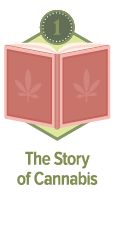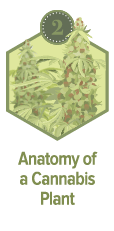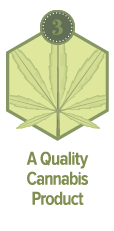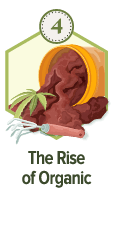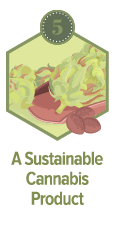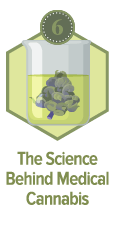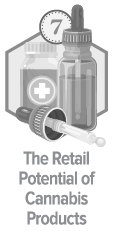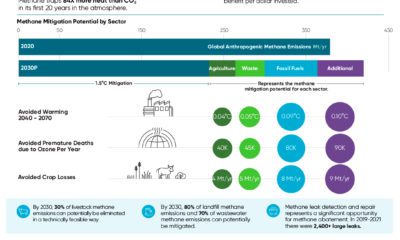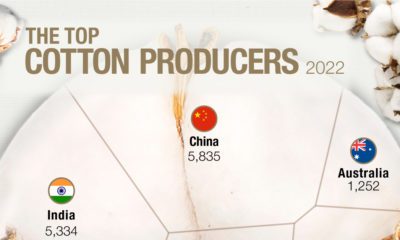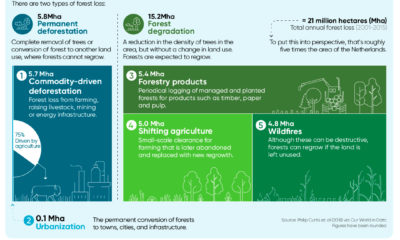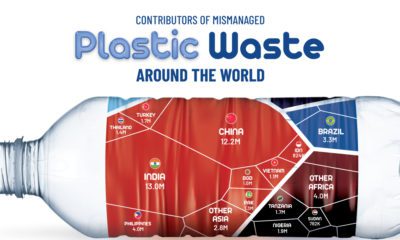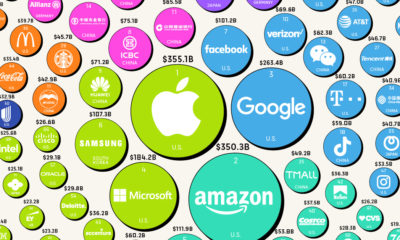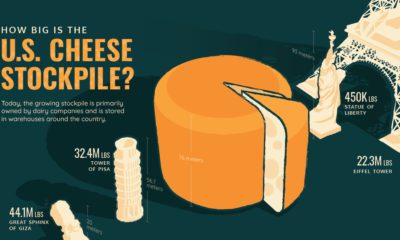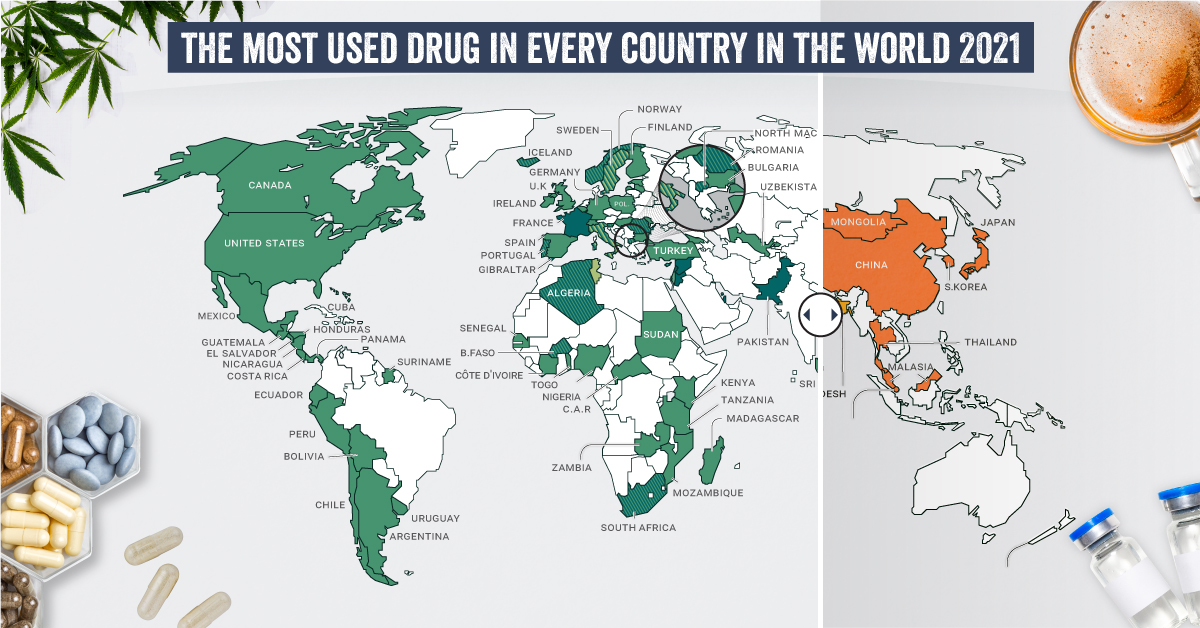Much like the way organic products have risen to prominence in supermarkets, consumers will start to demand high-quality products as the cannabis industry matures, as well. Today’s infographic comes from The Green Organic Dutchman, and it elaborates on why investors and consumers alike are anticipating a growing trend towards organic cannabis.
Roots of the Movement
In a nutshell, organic refers to products grown without fertilizers, pesticides, or genetic modifications. By that definition, organic practices also help to minimize the impact of farming on an environmental level. The organic trend originates in the post-WWII era, as technological advances transformed the efficiency of large-scale agriculture. As practices changed, farmers and scholars worried about the long-term effects that the use of synthetic chemicals could have. Thus, the organic movement was born: 1940 The phrase “organic farming” is first coined by English agriculturalist Lord Northbourne. 1962 The book “Silent Spring” by Rachel Carson raises public awareness of the harms posed by pesticides, launching the contemporary environmental movement. 1972 The International Federation of Organic Movements (IFOM), a worldwide organization for the organic agriculture movement, is founded. 1990 The U.S. passes the Organic Food Production Act (OFPA), defining standard organic production practices.
The Allure of Organic Cannabis
Consumers are expecting the same quality standards from other products they consume, such as cannabis. Growing cannabis organically ensures that it is:
- Safe for consumption Natural cultivation methods mean that organic cannabis is often a safer end-product.
- A premium experience Organic cannabis offers consumers improved flavor and quality, with enhanced potency.
- Environmentally sustainable With organic practices, the surrounding water, soil, and biodiversity are unharmed.
Fine Print?
One caveat to choosing organic is the price differential. One gram of organic cannabis can cost 26% more than regular grade cannabis – but that’s because organic cultivation requires more attention to detail. Nevertheless, increasing consumer demand for less chemically-laden products can outweigh this price differential in many cases. The growing market for cannabis is now on track to bring in $10 billion this year – outpacing all previous estimates. Stay tuned for part 5 of this series, which will look at the way growing organic cannabis can be complemented by sustainable practices.
on Humans have a storied and complicated relationship with drugs. Defined as chemical substances that cause a change in our physiology or psychology, many drugs are taken medicinally or accepted culturally, like caffeine, nicotine, and alcohol. But many drugs—including medicines and non-medicinal substances taken as drugs—are taken recreationally and can be abused. Each country and people have their own relationship to drugs, with some embracing the use of specific substances while others shun them outright. What are the most common drugs that are considered generally illicit in different parts of the world? Today’s graphics use data from the UN’s World Drug Report 2021 to highlight the most prevalent drug used in each country.
What Types of Common Drugs Are Tracked?
The World Drug Report looks explicitly at the supply and demand of the international illegal drug market, not including commonly legal substances like caffeine and alcohol. Drugs are grouped by class and type, with six main types of drugs found as the most prevalent drugs worldwide.
Cannabis*: Drugs derived from cannabis, including hemp. This category includes marijuana (dried flowers), hashish (resin), and other for various other parts of the plant or derived oils. Cocaine: Drugs derived from the leaves of coca plants. Labeled as either cocaine salts for powder form or crack for cocaine processed with baking soda and water into rock form. Opioids: Includes opiates which are derived directly from the opium poppy plant, including morphine, codeine, and heroin, as well as synthetic alkaloids. Amphetamine-type Stimulants (ATS): Amphetamine and drugs derived from amphetamine, including meth (also known as speed), MDMA, and ecstasy. Sedatives and Tranquilizers: Includes other drugs whose main purpose is to reduce energy, excitement, or anxiety, as well as drugs used primarily to initiate or help with sleep (also called hypnotics). Solvents and Inhalants: Gases or chemicals that can cause intoxication but are not intended to be drugs, including fuels, glues, and other industrial substances.
The report also tracked the prevalence of hallucinogens—psychoactive drugs which strongly affect the mind and cause a “trip”—but no hallucinogens ranked as the most prevalent drug in any one country. *Editor’s note: Recreational cannabis is legal in five countries, and some non-federal jurisdictions (i.e. states). However, in the context of this report, it was included because it is still widely illicit in most countries globally.
The Most Prevalent Drug in Each Country
According to the report, 275 million people used drugs worldwide in 2020. Between the ages of 15–64, around 5.5% of the global population used drugs at least once. Many countries grouped different types of the same drug class together, and a few like Saudi Arabia and North Macedonia had multiple different drug types listed as the most prevalent. But across the board, cannabis was the most commonly prevalent drug used in 107 listed countries and territories: How prevalent is cannabis worldwide? 72 locations or more than two-thirds of those reporting listed cannabis as the most prevalent drug. Unsurprisingly these include countries that have legalized recreational cannabis: Canada, Georgia, Mexico, South Africa, and Uruguay.
How Common Are Opioids and Other Drugs?
Though the global prevalence of cannabis is unsurprising, especially as it becomes legalized and accepted in more countries, other drugs also have strong footholds. Opioids (14 locations) were the most prevalent drugs in the Middle-East, South and Central Asia, including in India and Iran. Notably, Afghanistan is the world’s largest producer of opium, supplying more than 90% of illicit heroin globally. Amphetamine-type drugs (9 locations) were the third-most common drugs overall, mainly in East Asia. Methamphetamine was the reported most prevalent drug in China, South Korea, and Japan, while amphetamine was only the most common drug in Bangladesh. However, it’s important to note that illicit drug usage is tough to track. Asian countries where cannabis is less frequently found (or reported) might understate its usage. At the same time, the opioid epidemic in the U.S. and Canada reflects high opioid usage in the West. As some drugs become more widespread and others face a renewed “war,” the landscape is certain to shift over the next few years.
